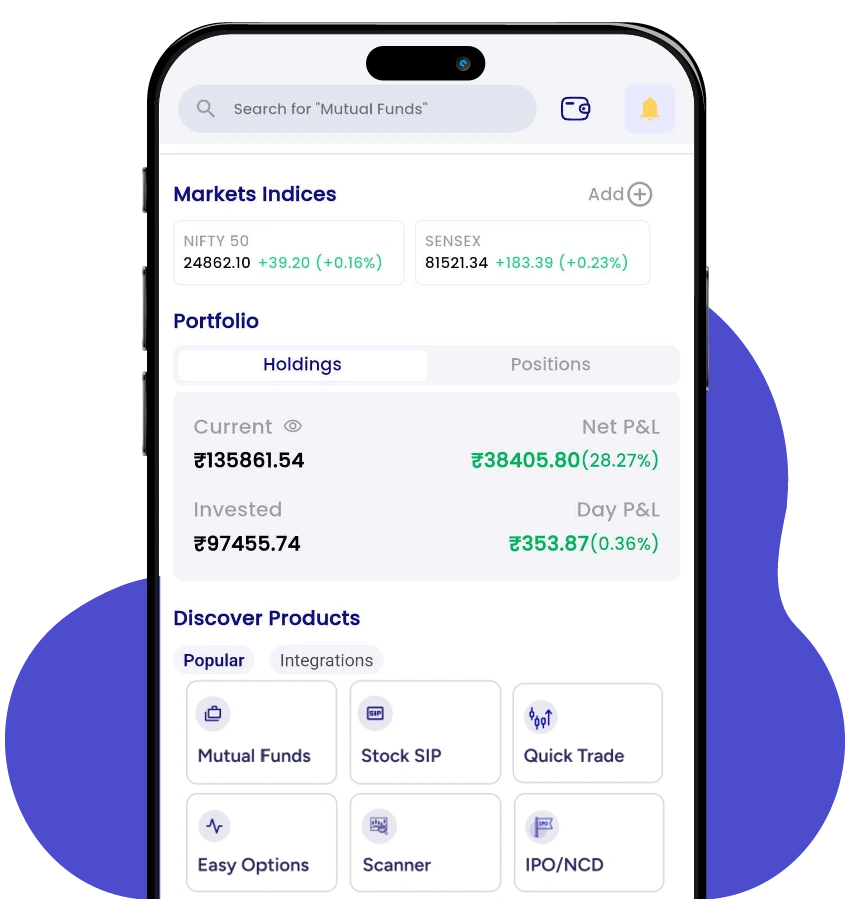What is Strike Price in Options?
- 18th July 2025
- 11:00 AM
- 8 min read
Did you know that nearly 91% of traders lost money in equity derivatives in FY25, according to SEBI? Well, to avoid such a scenario, it is crucial to understand the concept of derivatives. One of the most critical concepts is the strike price, often called the backbone of options trading.
In this blog, we break down what a strike price is, why it matters, and what to consider before choosing one.
Understanding the Concept of Strike Price
In options trading, investors have the right, but not the obligation, to buy or sell an asset at a set price on a particular date. This predetermined price is known as the strike price, through which you can exercise an option.
The strike price plays a pivotal role in determining the potential gain or loss of an option. A change in the underlying asset’s price influences the value of an options contract. Hence, it is crucial to pick a correct strike price.
To analyse the difference between a strike price and the current price of an underlying asset or spot price, you must also understand the concept of moneyness in options trading.
3 Types of Options Based on Strike Price and Market Value
Based on the type of options contract and the difference between spot price and strike price, an option can be classified into three categories: in-the-money (ITM) options, at-the-money (ATM) options, and out-of-the-money (OTM) options.
-
In-the-Money Options
An ITM option occurs when the strike price of an option is favourable to the current market price. For call options, an ITM option occurs when the current price of an underlying asset is higher than the strike price. In put options, the option is considered ITM when the current market price is lower than the strike price.
-
At-the-Money Options
At-the-money options come when the strike price is equal to the spot price for both call and put options.
-
Out-of-the-Money Options
When the spot price is not favourable to the strike price, it is considered an out-of-the-money option. OTM occurs when a spot price is lower than a strike price in call options. Contrarily, for put options, OTM occurs when a strike price is lower than the spot price.
Example of Strike Price in Options
Let us understand the strike price in options using an example. For instance, you believe the stock price of company X will increase after one month. The stock is currently trading at INR 100. You bought 100 shares with a call option contract at a strike price of INR 90 per share. You have paid a premium of INR 50 per share for this contract.
Simultaneously, the seller is expecting the price of stocks to fall, so they can sell stocks at a higher price than the market price. At expiry, the possible outcomes are:
- The spot price hits INR 120, which is more than the strike price. You can get a profit in this scenario.
- The spot price came down to INR 80, which is much less than the strike price. In this scenario, you may not exercise your contract and incur a loss of the premium paid to the seller.
What is the Significance of Strike Price in Options Trading?
Understanding what is strike price is extremely crucial since it is not just a price, it is a strategic decision that influences the position of your options contract. Let us understand its importance with three different strike prices, to make it easier for you.
-
Scenario 1
For example, the share price of Company Y is trading at INR 10,000. Akash expects the price to rise to INR 12,000. He purchases a call option with a strike price of INR 11,000 by paying a premium of INR 50.
As the stock price rises and reaches INR 11,000, Akash’s call option becomes at-the-money (ATM). Due to this upward movement and increasing demand, the option’s premium increases to INR 75, reflecting its improved potential for profitability.
However, the stock price moved to INR 12,000 after some days. Since the stock is trading above your strike price, the call option is now considered ITM, and its premium has increased to INR 90.
-
Scenario 2
Meanwhile, another trader, Vikas, predicted the stock price to fall and bought a put option at a strike price of INR 9,000 for a premium of INR 100. However, since the price moved in the opposite direction, the option has been pushed from ITM to OTM, and the premium has also declined.
-
Scenario 3
Prakash, a third trader, predicted the price to go upwards as well and purchased a call option at a strike price of INR 13,000. As the spot price was lower than the strike price, the option expired worthless, and he had to incur the premium as a loss.
According to these three situations, you can see how important it is to choose the right strike price to avoid losses. Despite the stock price rising, the call option made by Prakash was found OTM on the expiry date and expired worthless.
You can easily avoid these common pitfalls by using the long-term investing recommendations of PL Capital Group – Prabhudas Lilladher. With PL Capital, you can open a trading account with zero AMC charges.
Considerations for Choosing a Strike Price
Derivative trading is extremely risky and can lead to huge losses if not done properly. Follow the considerations before choosing a strike price:
-
Risk Tolerance
Different types of options contracts have different levels of risk. You should decide a strike price based on your ability to take risks. ITM strike prices are very sensitive to price movements of an asset, while OTM options have the highest risks. The ITM is good for buyers, and the OTM option is highly suitable for sellers.
-
Liquidity
The liquidity of a security determines how much you can make through a trade. You should always check it before choosing a strike price. Securities with high liquidity provide better profits before the expiration of the contract. Contrarily, you cannot get enough profit from a security with lower liquidity.
-
Premium
You need to analyse the premium you have paid for the asset and the breakeven point for the capital. After that, try to keep your strike price at a level that allows you to remain close to the breakeven point. Higher premiums make an option more expensive. OTM premiums have lower premiums while ITM premiums are higher than ATM premiums.
-
Bid-Ask Spread
You should evaluate the bid-ask spread before choosing a strike price. The reason is that some strike prices differ between the bid price and the offer price. Some traders considered the ‘last traded price’ before entering a trade and neglected the bid-offer prices. This results in unexecuted orders.
-
Option Chain
Last but not least, you must always evaluate the options chain data while choosing a strike price. Evaluating the option chain, you can track numerous strike prices and analyse the changes in the open interest.
Final Thoughts
Several investors make incorrect decisions while picking the right strike price. Options trading can be a very profitable avenue if you follow proper risk management procedures while choosing a strike price. Having a decent knowledge of the difference between a spot price and a strike price, you can effectively manage your options portfolio.
Want to invest in options trading with experts’ insights? Download the PL Capital application to get live market updates and advanced charting and analysis.
Frequently Asked Questions
1. How is a strike price different from a stock price?
A strike price is the predetermined price that allows you to exercise an options contract. On the other hand, a spot price is the current market price of the security at any time.
2. What is a put strike price?
A put strike price is the predetermined price at which you can exercise your put option. It gives you the right but not the obligation to sell an asset.
3. Is a strike price important in option buying?
Yes, a strike price is important to buy options. It directly influences the profitability of an options contract and also determines the moneyness of an option.





